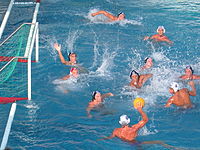
Photo from wikipedia
We investigated the ability of football teams to develop a particular playing style by looking at their passing patterns. Using the information contained in the pass sequences during matches, we… Click to show full abstract
We investigated the ability of football teams to develop a particular playing style by looking at their passing patterns. Using the information contained in the pass sequences during matches, we constructed the pitch passing networks of teams, whose nodes are the divisions of the pitch for a given spatial scale and links account for the number of passes from region to region. We translated football passings networks into their corresponding adjacency matrices. We calculated the correlations between matrices of the same team to quantify how consistent the passing patterns of a given team are. Next, we quantified the differences with other teams’ matrices and obtained an identifiability parameter that indicates how unique are the passing patterns of a given team. Consistency and identifiability rankings were calculated during a whole season, allowing to detect those teams of a league whose passing patterns are different from the rest. Furthermore, we found differences between teams playing at home or away. Finally, we used the identifiability parameter to investigate what teams imposed their passing patterns over the rivals during a given match.
Journal Title: Scientific Reports
Year Published: 2020
Link to full text (if available)
Share on Social Media: Sign Up to like & get
recommendations!